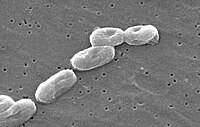
Photo from wikipedia
Pseudomonas aeruginosa and Burkholderia cenocepacia are important opportunistic pathogens often found together in the airways of persons with cystic fibrosis. Laboratory cocultures of both species often ends with one taking… Click to show full abstract
Pseudomonas aeruginosa and Burkholderia cenocepacia are important opportunistic pathogens often found together in the airways of persons with cystic fibrosis. Laboratory cocultures of both species often ends with one taking over the other. ABSTRACT Interactions between different bacterial species shape bacterial communities and their environments. The opportunistic pathogens Pseudomonas aeruginosa and Burkholderia cenocepacia both can colonize the lungs of individuals affected by cystic fibrosis. Using the social surface behavior called swarming motility as a study model, we noticed intricate interactions between B. cenocepacia K56-2 and P. aeruginosa PA14. While strain K56-2 does not swarm under P. aeruginosa favorable swarming conditions, co-inoculation with a nonmotile PA14 flagellum-less ΔfliC mutant restored spreading for both strains. We show that P. aeruginosa provides the wetting agent rhamnolipids allowing K56-2 to perform swarming motility, while aflagellated PA14 appears to “hitchhike” along with K56-2 cells in the swarming colony. IMPORTANCE Pseudomonas aeruginosa and Burkholderia cenocepacia are important opportunistic pathogens often found together in the airways of persons with cystic fibrosis. Laboratory cocultures of both species often ends with one taking over the other. We used a surface motility assay to study the social interactions between populations of these bacterial species. Under our conditions, B. cenocepacia cannot swarm without supplementation of the wetting agent produced by P. aeruginosa. In a mixed colony of both species, an aflagellated mutant of P. aeruginosa provides the necessary wetting agent to B. cenocepacia, allowing both bacteria to swarm and colonize a surface. We highlight this peculiar interaction where both bacteria set aside their antagonistic tendencies to travel together.
Journal Title: mSphere
Year Published: 2022
Link to full text (if available)
Share on Social Media: Sign Up to like & get
recommendations!